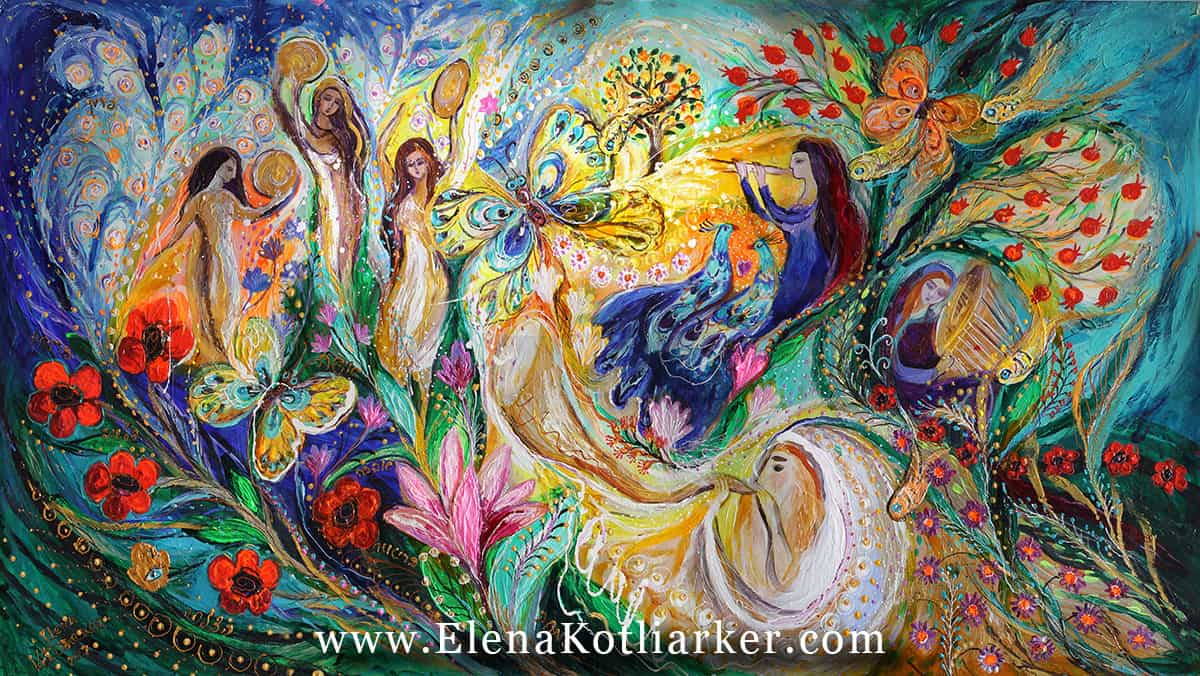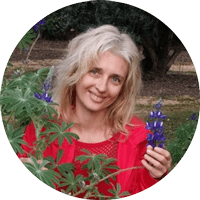I am proud to be featured on the Israeli news site on French Jforum.fr, big thanks to Albert Bensoussan who wrote this article.
The article has been written in French and automatically translated by Google.
Follow the link to read the original article on Jforum.fr:
https://www.jforum.fr/tehilim-lhymne-a-la-joie.html
Written by:
Albert Bensoussan
Tehilim: the hymn to joy
Either Psalm 150, as represented in this painting by Elena Kotliarker. The colors sing, the dancers, levitating, bustle about their tambourine, the flautist and the harpist surrender to the music, while a rabbi covered with the tallit sounds the shofar. In a profusion of flowers where red dominates and the prolix round of pomegranates.
“In my paintings, I do my utmost to bring out the abundant beauty and splendor that is seen in Jewish art. In my method, I do this by incorporating the many Jewish symbols and icons that have developed over many centuries of our rich history and heritage. The symbols primarily identify the signs of fortune in Kabbalah like good health, prosperity, fertility, etc. I believe that when a person looks at the image and detects the signs, fortune happens to him ”, this is the aesthetic aim of the painter Elena Kotliarker, born in Kiev in 1969, having made her alya in 1996.
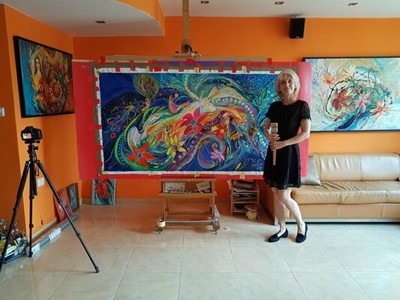
Elena Kotliarker in her studio, in front of these large canvases of biblical exaltation. Deborah, my wife, was ecstatic in front of her acquisition and her speech is registered on the artist’s Wall :
“Your beautiful painting arrived today – I am amazed that it got here so quickly. I love your use of color and the flow of your work. You are very talented !!! I will be getting your painting framed next week and look forward to getting it up on my wall. Thank you for your lovely work. All the best to you!
Deb “
Then, after the framing of this painting, this appreciation that followed on Elena Kotliarker’s “Wall”:
“I just wanted to send you a picture of the painting I bought from you, which is now hanging in our living room. I love it…. And have already received so much positive feedback about it from my friends who have seen it. Thank you for creating such a lovely piece of artwork. It makes me happy just to look at it. Deb “
The title of this table corresponds to verse 4 of Psalm 150, the last of Tehilim and the most singing and dancing: “Praise him with the tambourine and the dance instruments”, or, in André Chouraqui’s translation: “Praise -the tambourine, the dance ”, Hallelouhou vetof or ma’hol : the tambourine is said tof תפ, admirably expressive word with the deaf stop consonant “t” whose sound suggests the blow, the light shock of the hand on the skin of the drum, and the “f”, preceded by the vocalization in this “o” as round as l ‘instrument, evokes, by this labio-dental consonant where the lower lip approaches the upper teeth and brushes them while blowing, the propagation of sound; repeat tof-tof-tof-tof several times and you get the musical drumming, such is the miracle of the Hebrew sonority. And ma’hol מחול is the dance, from the verb ‘hol חול = to dance, where one can feel the friction of the clothes by the “‘ het”, the whirling with the “o”, the “l” probably evoking l ‘flight, and certainly grace, if we remember that flight is said in Hebrew הולך , holakh. This philological insistence serves, in my eyes, to better understand this incredible whirling of bodies, flowers, and colors in Elena Kotliarker’s painting, whose grace is accentuated by the flight of butterflies and the presence of two peacocks at the ocellated tail surrounding the flute player.
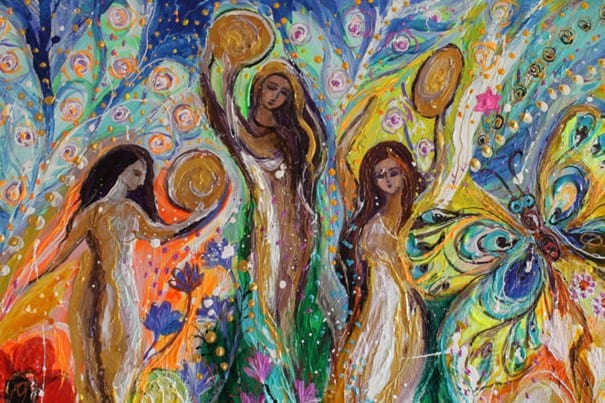
But this verse 4 ends with the music of the minim strings and the flute ‘ougav : מנים־ועוגב played by the female figure on the far right. What to say about this Hebrew flute except that the ‘oug is this verb עוג which means to make a circle, and therefore here to round the mouth to put the recorder in it, but how can we not also see that this vocalized word עוגב ‘ oguev means ” lover ” ? The flute is indeed the instrument of love. For any music lover, the flute solo evokes the masterful Prelude to the Afternoon of a Faun of which Claude Debussy, its composer, said there to express “the different atmospheres, in the midst of which evolve the desires, and the dreams of Egipan, by this scorching afternoon. Tired of pursuing fearful nymphs and timid naiads, he surrenders to a voluptuous sleep animated by the dream of a desire finally realized: complete possession of the whole of nature ”. And here it is, that my dictionary of Abraham Elmaleh tells me that ‘oguev , as an adjective, means “voluptuous”. And we will notice that the flute player is represented on the painting softly seated, voluptuously posed.
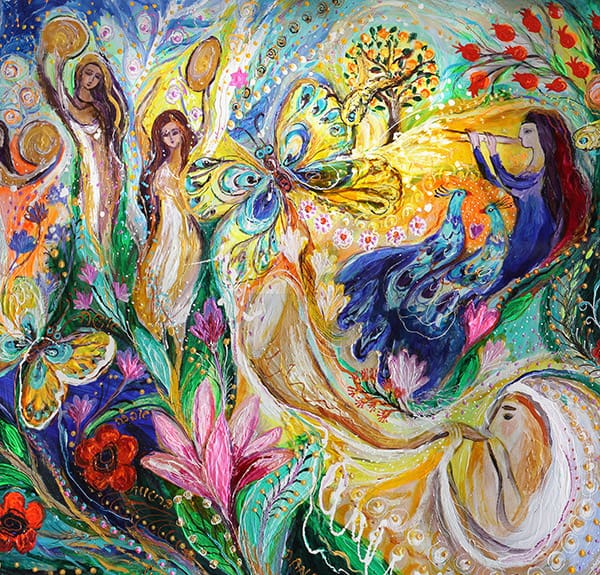
At the bottom right of the painting, an immense and tortuous shofar is unrolled, glued to the lips of a rabbi whose head is covered with the ritual shawl. The image corresponds to verse three: “Praise him by the sound of the shofar” – Shuraqui translates: “Praise him by the shine of the shophar”, in Hebrew beteqa ‘chofar בתקע־שופר. The word teqa ‘ תקע means the sound of a trumpet, and the verb taqoa’ which is spelled the same means to sound the trumpet. This tk sound predominates in the ringing of the shofar on Rosh Hashanah and Kippur in two of its three modalities: Teki’ah תקיעה (= sound of the horn), first sound on two notes, insistent and plaintive, then teroua’h תרועה(= sound of the trumpet), resounding ringing served by the long breath of the bell ringer, who is called Ba’al teki’ah , who, after having inserted the three complaints of the chevarim שברים mode (= musical trill), returns to the teki ‘ ah , to finish on teki’ah guedola where he blows from his two lungs endlessly: tou-tou-tou-tou-tou…, thus signaling the breaking of the fast, the closing of Yom Kippur. (I have my chofar on the table, but I have no more breath to bring it to my lips, I am no longer Ba’al master בעל of me.) We will notice on the canvas all these white twists extending the bottom of the tallit as so many notes supporting the torso form of the שופר(= olifant, which we will notice, although in French this medieval horn takes its name from the ivory of the elephant, euphonic kinship, with this triumphant “f” sound).
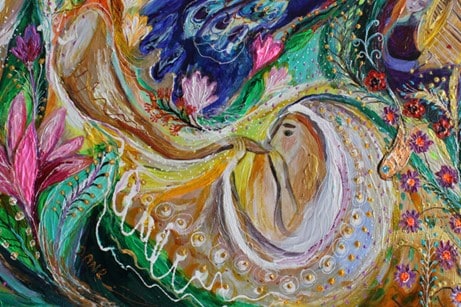
And the end of verse 3, in the continuity of the wind instruments, summons the lute nevel נבל and the harp khinor כנור that we see in the hands of the musician, in a round that mixes the arm of the young girl, the roundness of the instrument and a Chagallian fish which is always a symbol of wealth, and moreover dag דג , the fish, derives from the verb dagoh דגה , which means to grow, to multiply, unless it is the reverse, but the miraculous catch is never far away.
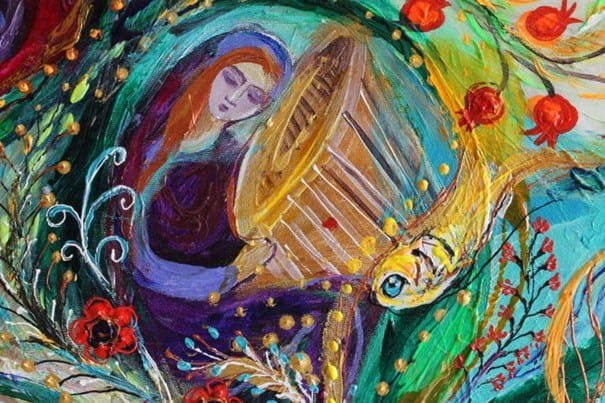
As the artist specifies in his aesthetic statement, this painting, filled with positive signs and symbols, is intended as a support for meditation – for prayer – suitable for leading to serenity, wisdom and happiness. And precisely the whole Tehillim has this purpose, which is why there are psalms for all moments of life, and even for mourning that leads to the cemetery – Beit Ha’hayyim בית־החיים -, which is the house of life, to recite Psalm 119, each paragraph of which begins, successively, with one of the twenty-two letters of the Hebrew alphabet, which makes it possible to state the name of the deceased in its different letters and by reciting the corresponding verses, so of my name when I am in the pit – bor בור – Abraham ben Shmoel אברהם־בן־שמואל , and the paragraphs Ashré Bameh Réeh Horeni Ma-ahavti / Bameh Ner-leragli / Sarim Ma-ahavti Viboouni Ashré Le’olam will be recited below. And the Kaddish will follow …
The Tehilim ends with a permanent exaltation, the “Hallel” which means “that He be praised”, a set of psalms which open and end with the word “Hallelouyah” which means “Praise be to God ( Yah) ”. So are the last five Psalms of Tehilim, preceded by 5 others, scattered (106, 111, 112, 113 and 135). Everything then is only music and the solicitation of all the instruments, of which we know today, sometimes, only the name: string and wind instruments, voice of the choir and of the corypheus – the choirmaster, called menatsea ‘ h מנצח.Psalm 150, the last, is in this regard the “hymn to joy” of Judaism, where God is praised in his sanctuary and in the firmament, in his power and his greatness, to the sound of the shofar, the lute and the harp, tambourine, flute and resounding cymbals – the very suggestive tsiltseley צלצלי where we can clearly perceive the shock of the two צלcymbals – by mobilizing dancing bodies and singing voices. It is enough to read it and sing it in Hebrew to understand that each word is itself music. Ultimately, the Tehillim, which is a refuge and recourse against doubt, sadness, illness and mourning, is for everyone a book of songs, a book of joyful and helpful piety, a poetic manual of survival. That we recite, that we sing this psalm 150, or that we contemplate the painting of Elena Kotliarker which illustrates it so wonderfully, and we will feel this joyful exaltation, suitable to drive out dark ideas, the born depression. a conjunctural confinement or psychological confinement which has affected the individual since the dawn of time and sometimes makes him wish for darkness while erasing the day. A happy hamsa, with one eye in the hand – that we used to call, in Algeria, El-‘ayn fil yad , العين في اليد in the language of my mother born in Nedroma – reinforces on the canvas, bottom left, in the middle of all those red poppies, luck, mazal מזל. Yes, this painting is a lucky charm, a luck factor. And now, perhaps, miraculously, the hatslahah הצלחה, this word that the artist arouses and inscribes in his canvas, and which calls upon us prosperity, success and happiness, will touch us, get us back on track, on the path of serenity, finally relieve our anguish of uncertain times, our fear of dying, like a soothing ointment or a beneficial oil, coats us with wisdom, with peace of the soul, which is always this radical harmony with life. And we will push, at the end of the Tehilim, while proclaiming Hallelouyah הללויה , the only possible cry, the only wish:
חיה־את־החיים Long live life!
Albert Bensoussan

